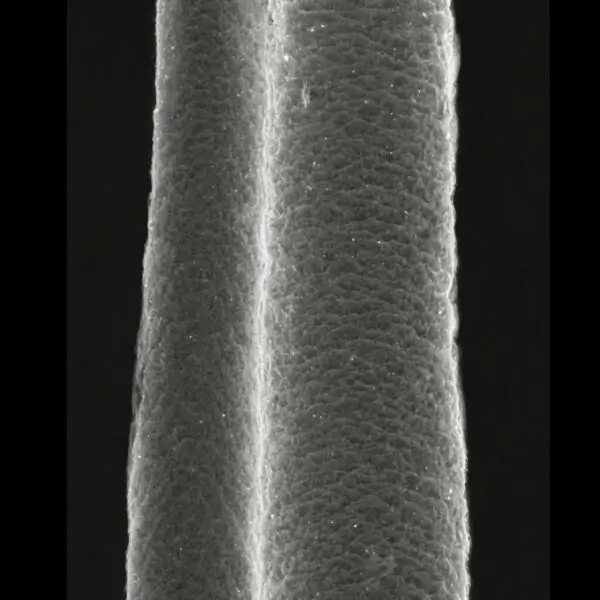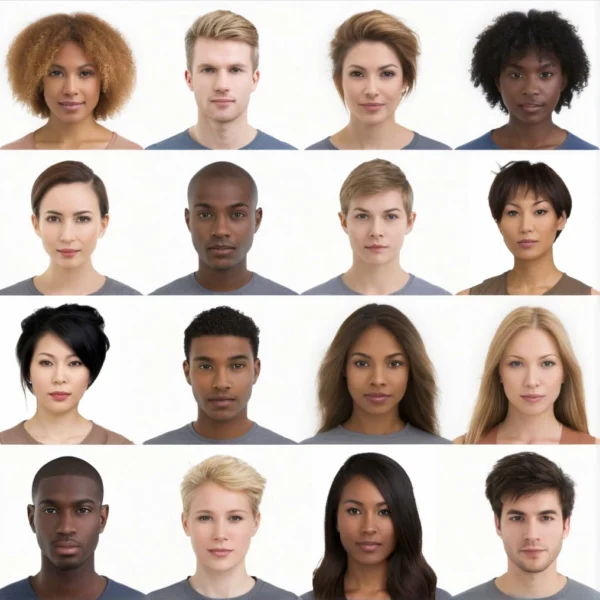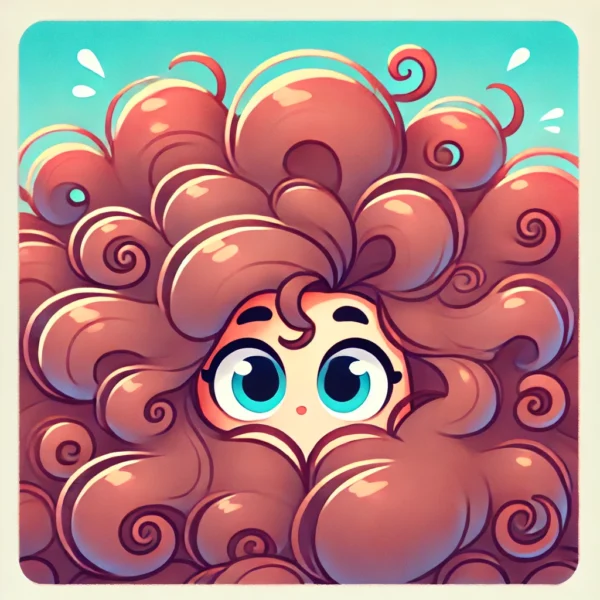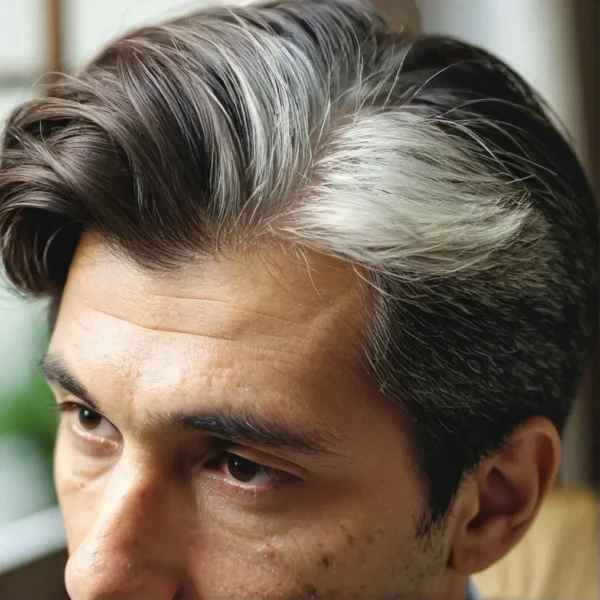Grooved hair, or pili canaliculi, is a rare and unusual condition where hair fibers exhibit longitudinal grooves running along their length. This condition can affect individuals of any age, sex, or ethnicity, although its prevalence and severity can vary. The grooves in the hair can lead to various hair abnormalities, including increased fragility, altered texture, and changes in hair appearance. Understanding the etiology, diagnosis, and potential treatments of grooved hair is useful for researchers and clinicians in the field of dermatology and trichology.
Etiology: The exact causes of grooved hair are not fully understood, but several factors have been proposed to contribute to its development. These factors can be broadly categorized into genetic, environmental, and physiological influences.
Genetic Factors: There is evidence suggesting that grooved hair can have a genetic basis, with mutations in specific genes potentially leading to the structural anomalies observed in hair fibers. Genetic disorders that affect hair shaft formation and keratinization can manifest as grooved hair among other phenotypic characteristics.Environmental Factors: External influences such as chemical exposure, physical damage from styling practices, and extreme environmental conditions may contribute to the development of grooved hair. These factors can alter the hair’s growth, damage the cuticle, and affect the hair shaft’s integrity.Physiological Factors: Nutritional deficiencies, hormonal imbalances, and systemic illnesses have been associated with changes in hair texture and structure, including the formation of grooves in hair fibers. These conditions can disrupt the normal biology of hair follicles, leading to altered hair shaft production. Clinical Presentation and Diagnosis: Grooved hair typically presents as hair strands with noticeable longitudinal grooves visible under microscopic examination. The grooves may run for part or all of the hair fiber length and there can be more than one longitudinal groove present. With just one groove the hair has a quarter moon cross section shape. With two grooves it may have an hour glass cross section shape, and with three or more grooves the cross section is more star shaped. Affected individuals may report hair that is brittle, prone to breakage, and difficult to manage.
In some cases, grooved hair may be an incidental finding during a routine examination for other scalp or hair disorders. Diagnosis of grooved hair involves a thorough clinical evaluation, including a detailed patient history and physical examination of the hair and scalp. Dermoscopy and light microscopy are valuable tools for visualizing the grooves in hair fibers, facilitating an accurate diagnosis. Additionally, trichograms and scanning electron microscopy can provide detailed insights into the hair shaft’s morphology and the extent of the grooving.
Implications and Associated Conditions: Grooved hair can be an isolated finding or part of a broader syndrome involving other cutaneous or systemic abnormalities. Almost all of us have a few grooved hairs here and there on our scalp. Men tend to have more grooved hair in their beards and these can be relatively stiff and inflexible fibers. These are not a cause for concern unless the numbers of grooved hairs increases significantly. One article suggests for clinical changes to be apparent, at least 50% of hairs must be affected.
Having a high percentage of hairs with grooves has been observed in association with various genetic disorders and dermatological conditions, highlighting the importance of a comprehensive evaluation to identify any underlying issues. Examples of genetic conditions that involve grooved hair include; trichothiodystrophy, pili torti, uncombable hair syndrome, argininosuccinase deficiency, and ectodermal dysplasias.
The presence of a significant amount of grooved hair can impact an individual’s quality of life, primarily due to cosmetic concerns and the hair’s increased fragility. Understanding the potential implications and associated conditions is important for managing patients with grooved hair effectively.
Current Research and Treatments: Research into the conditions underlying grooved hair is ongoing, with studies focusing on elucidating the genetic, molecular, and environmental factors contributing to its development. Advances in genetic sequencing and imaging technologies have provided valuable insights into the structural abnormalities of hair fibers and the potential mechanisms underlying this hair fiber feature.
Treatment options for grooved hair are limited and primarily aimed at managing the symptoms and preventing further hair damage. Recommendations may include the use of gentle hair care practices, avoiding harsh chemicals and heat styling, and addressing any nutritional deficiencies or underlying health issues. In some cases, topical treatments or supplements may be suggested to improve hair health, although evidence supporting their efficacy is limited.
Conclusion: Grooved hair, with its distinctive longitudinal grooves along the hair fiber, offers a unique window into the complex biology of hair growth and development. While having a high percentage of grooved hairs is rare and often a cosmetic concern, it can serve as a marker for underlying genetic or systemic disorders for a few people. The pursuit of a deeper understanding of grooved hair’s causes and mechanisms holds promise for developing targeted treatments and management strategies.
Bibliography
11711645 {11711645:VIKTVPWQ},{11711645:FBHD5BIW},{11711645:CKVZSC2E},{11711645:NZJ7RF7F},{11711645:E4H9V7IF},{11711645:V6X3CV87},{11711645:X8AEC6CT},{11711645:P3R69Z4K},{11711645:3ME79PAA} 1 vancouver 50 date asc 1180 https://www.keratin.com/wp-content/plugins/zotpress/ %7B%22status%22%3A%22success%22%2C%22updateneeded%22%3Afalse%2C%22instance%22%3Afalse%2C%22meta%22%3A%7B%22request_last%22%3A0%2C%22request_next%22%3A0%2C%22used_cache%22%3Atrue%7D%2C%22data%22%3A%5B%7B%22key%22%3A%22V6X3CV87%22%2C%22library%22%3A%7B%22id%22%3A11711645%7D%2C%22meta%22%3A%7B%22creatorSummary%22%3A%22Mehregan%20and%20Thompson%22%2C%22parsedDate%22%3A%221979-03%22%2C%22numChildren%22%3A0%7D%2C%22bib%22%3A%22%26lt%3Bdiv%20class%3D%26quot%3Bcsl-bib-body%26quot%3B%20style%3D%26quot%3Bline-height%3A%201.35%3B%20%26quot%3B%26gt%3B%5Cn%20%20%26lt%3Bdiv%20class%3D%26quot%3Bcsl-entry%26quot%3B%20style%3D%26quot%3Bclear%3A%20left%3B%20%26quot%3B%26gt%3B%5Cn%20%20%20%20%26lt%3Bdiv%20class%3D%26quot%3Bcsl-left-margin%26quot%3B%20style%3D%26quot%3Bfloat%3A%20left%3B%20padding-right%3A%200.5em%3B%20text-align%3A%20right%3B%20width%3A%201em%3B%26quot%3B%26gt%3B1.%26lt%3B%5C%2Fdiv%26gt%3B%26lt%3Bdiv%20class%3D%26quot%3Bcsl-right-inline%26quot%3B%20style%3D%26quot%3Bmargin%3A%200%20.4em%200%201.5em%3B%26quot%3B%26gt%3BMehregan%20AH%2C%20Thompson%20WS.%20Pili%20multigemini.%20Report%20of%20a%20case%20in%20association%20with%20cleidocranial%20dysostosis.%20Br%20J%20Dermatol.%201979%20Mar%3B100%283%29%3A315%26%23x2013%3B22.%26lt%3B%5C%2Fdiv%26gt%3B%5Cn%20%20%20%26lt%3B%5C%2Fdiv%26gt%3B%5Cn%26lt%3B%5C%2Fdiv%26gt%3B%22%2C%22data%22%3A%7B%22itemType%22%3A%22journalArticle%22%2C%22title%22%3A%22Pili%20multigemini.%20Report%20of%20a%20case%20in%20association%20with%20cleidocranial%20dysostosis%22%2C%22creators%22%3A%5B%7B%22creatorType%22%3A%22author%22%2C%22firstName%22%3A%22A.%20H.%22%2C%22lastName%22%3A%22Mehregan%22%7D%2C%7B%22creatorType%22%3A%22author%22%2C%22firstName%22%3A%22W.%20S.%22%2C%22lastName%22%3A%22Thompson%22%7D%5D%2C%22abstractNote%22%3A%22A%20patient%20with%20cleidocranial%20dysostosis%20developed%20extensive%20pili%20multigemini%20over%20the%20heavily%20bearded%20chin%20and%20cheek%20areas.%20Histological%20examination%20of%20serial%20sections%20revealed%20complicated%20follicular%20structures%20forming%20from%20two%20to%20as%20many%20eight%20hair%20shafts.%20Each%20hair%20is%20formed%20by%20a%20single%20branch%20of%20dermal%20papilla%20which%20is%20surrounded%20by%20all%20layers%20present%20in%20a%20normal%20follicle%20except%20for%20the%20outer%20root%20sheath%20cells.%20The%20outer%20root%20sheath%20surrounds%20the%20entire%20follicle.%20Irregularities%20in%20configuration%20of%20the%20hairs%2C%20longitudinal%20grooving%20and%20areas%20of%20bifurcation%20and%20re-adhesion%20of%20the%20hair%20shafts%20are%20demonstrated.%22%2C%22date%22%3A%221979-03%22%2C%22language%22%3A%22eng%22%2C%22DOI%22%3A%2210.1111%5C%2Fj.1365-2133.1979.tb06205.x%22%2C%22ISSN%22%3A%220007-0963%22%2C%22url%22%3A%22%22%2C%22collections%22%3A%5B%22P8B2G8G5%22%5D%2C%22dateModified%22%3A%222024-02-10T15%3A39%3A08Z%22%7D%7D%2C%7B%22key%22%3A%22P3R69Z4K%22%2C%22library%22%3A%7B%22id%22%3A11711645%7D%2C%22meta%22%3A%7B%22creatorSummary%22%3A%22Rest%20and%20Fretzin%22%2C%22parsedDate%22%3A%221990-06%22%2C%22numChildren%22%3A0%7D%2C%22bib%22%3A%22%26lt%3Bdiv%20class%3D%26quot%3Bcsl-bib-body%26quot%3B%20style%3D%26quot%3Bline-height%3A%201.35%3B%20%26quot%3B%26gt%3B%5Cn%20%20%26lt%3Bdiv%20class%3D%26quot%3Bcsl-entry%26quot%3B%20style%3D%26quot%3Bclear%3A%20left%3B%20%26quot%3B%26gt%3B%5Cn%20%20%20%20%26lt%3Bdiv%20class%3D%26quot%3Bcsl-left-margin%26quot%3B%20style%3D%26quot%3Bfloat%3A%20left%3B%20padding-right%3A%200.5em%3B%20text-align%3A%20right%3B%20width%3A%201em%3B%26quot%3B%26gt%3B1.%26lt%3B%5C%2Fdiv%26gt%3B%26lt%3Bdiv%20class%3D%26quot%3Bcsl-right-inline%26quot%3B%20style%3D%26quot%3Bmargin%3A%200%20.4em%200%201.5em%3B%26quot%3B%26gt%3BRest%20EB%2C%20Fretzin%20DF.%20Quantitative%20assessment%20of%20scanning%20electron%20microscope%20defects%20in%20uncombable-hair%20syndrome.%20Pediatr%20Dermatol.%201990%20June%3B7%282%29%3A93%26%23x2013%3B6.%26lt%3B%5C%2Fdiv%26gt%3B%5Cn%20%20%20%26lt%3B%5C%2Fdiv%26gt%3B%5Cn%26lt%3B%5C%2Fdiv%26gt%3B%22%2C%22data%22%3A%7B%22itemType%22%3A%22journalArticle%22%2C%22title%22%3A%22Quantitative%20assessment%20of%20scanning%20electron%20microscope%20defects%20in%20uncombable-hair%20syndrome%22%2C%22creators%22%3A%5B%7B%22creatorType%22%3A%22author%22%2C%22firstName%22%3A%22E.%20B.%22%2C%22lastName%22%3A%22Rest%22%7D%2C%7B%22creatorType%22%3A%22author%22%2C%22firstName%22%3A%22D.%20F.%22%2C%22lastName%22%3A%22Fretzin%22%7D%5D%2C%22abstractNote%22%3A%22Uncombable-hair%20syndrome%20is%20a%20rare%20disorder%20of%20scalp%20hair%20that%20starts%20early%20in%20childhood.%20It%20is%20characterized%20clinically%20as%20unruly%20hair%20and%20by%20scanning%20electron%20microscopy%20as%20longitudinally%20grooved%20hairs%20with%20a%20triangular%20cross%20section.%20Because%20of%20the%20controversy%20of%20inheritance%20and%20prior%20reports%20of%20similar%20changes%20in%20normal%20and%20other%20hair%20disorders%2C%20we%20performed%20a%20quantitative%20scanning%20electron%20microscopic%20assessment%20of%20four%20patients%20with%20uncombable-hair%20syndrome%2C%20first-degree%20relatives%2C%20and%20nonaffected%20controls.%20Our%20results%20indicate%20that%20longitudinal%20grooving%20of%20scalp%20hair%20is%20a%20common%20occurrence%2C%20and%20that%20for%20clinical%20changes%20to%20be%20apparent%2C%20approximately%2050%25%20of%20hairs%20must%20be%20affected.%22%2C%22date%22%3A%221990-06%22%2C%22language%22%3A%22eng%22%2C%22DOI%22%3A%2210.1111%5C%2Fj.1525-1470.1990.tb00661.x%22%2C%22ISSN%22%3A%220736-8046%22%2C%22url%22%3A%22%22%2C%22collections%22%3A%5B%22P8B2G8G5%22%5D%2C%22dateModified%22%3A%222024-02-10T15%3A42%3A47Z%22%7D%7D%2C%7B%22key%22%3A%22CKVZSC2E%22%2C%22library%22%3A%7B%22id%22%3A11711645%7D%2C%22meta%22%3A%7B%22creatorSummary%22%3A%22Kvedar%20et%20al.%22%2C%22parsedDate%22%3A%221991-08-01%22%2C%22numChildren%22%3A0%7D%2C%22bib%22%3A%22%26lt%3Bdiv%20class%3D%26quot%3Bcsl-bib-body%26quot%3B%20style%3D%26quot%3Bline-height%3A%201.35%3B%20%26quot%3B%26gt%3B%5Cn%20%20%26lt%3Bdiv%20class%3D%26quot%3Bcsl-entry%26quot%3B%20style%3D%26quot%3Bclear%3A%20left%3B%20%26quot%3B%26gt%3B%5Cn%20%20%20%20%26lt%3Bdiv%20class%3D%26quot%3Bcsl-left-margin%26quot%3B%20style%3D%26quot%3Bfloat%3A%20left%3B%20padding-right%3A%200.5em%3B%20text-align%3A%20right%3B%20width%3A%201em%3B%26quot%3B%26gt%3B1.%26lt%3B%5C%2Fdiv%26gt%3B%26lt%3Bdiv%20class%3D%26quot%3Bcsl-right-inline%26quot%3B%20style%3D%26quot%3Bmargin%3A%200%20.4em%200%201.5em%3B%26quot%3B%26gt%3BKvedar%20JC%2C%20Baden%20HP%2C%20Baden%20LA%2C%20Shih%20VE%2C%20Kolodny%20EH.%20Dietary%20management%20reverses%20grooving%20and%20abnormal%20polarization%20of%20hair%20shafts%20in%20argininosuccinase%20deficiency.%20Am%20J%20Med%20Genet.%201991%20Aug%201%3B40%282%29%3A211%26%23x2013%3B3.%26lt%3B%5C%2Fdiv%26gt%3B%5Cn%20%20%20%26lt%3B%5C%2Fdiv%26gt%3B%5Cn%26lt%3B%5C%2Fdiv%26gt%3B%22%2C%22data%22%3A%7B%22itemType%22%3A%22journalArticle%22%2C%22title%22%3A%22Dietary%20management%20reverses%20grooving%20and%20abnormal%20polarization%20of%20hair%20shafts%20in%20argininosuccinase%20deficiency%22%2C%22creators%22%3A%5B%7B%22creatorType%22%3A%22author%22%2C%22firstName%22%3A%22J.%20C.%22%2C%22lastName%22%3A%22Kvedar%22%7D%2C%7B%22creatorType%22%3A%22author%22%2C%22firstName%22%3A%22H.%20P.%22%2C%22lastName%22%3A%22Baden%22%7D%2C%7B%22creatorType%22%3A%22author%22%2C%22firstName%22%3A%22L.%20A.%22%2C%22lastName%22%3A%22Baden%22%7D%2C%7B%22creatorType%22%3A%22author%22%2C%22firstName%22%3A%22V.%20E.%22%2C%22lastName%22%3A%22Shih%22%7D%2C%7B%22creatorType%22%3A%22author%22%2C%22firstName%22%3A%22E.%20H.%22%2C%22lastName%22%3A%22Kolodny%22%7D%5D%2C%22abstractNote%22%3A%22We%20have%20observed%20that%20the%20fragile%20hair%20of%20two%20untreated%20patients%20with%20argininosuccinic%20aciduria%20showed%20abnormal%20alternating%20zones%20of%20bright%20and%20dark%20banding%20by%20polarizing%20microscopy.%20Scanning%20electron%20microscopy%20documented%20discontinuous%20grooves%20with%20a%2050%20to%20100%20microns%20periodicity.%20Results%20of%20amino%20acid%20analysis%20of%20the%20hair%20were%20essentially%20normal.%20After%20the%20patients%20were%20treated%20with%20a%20low-protein%2C%20arginine-supplemented%20diet%2C%20the%20hair%20assumed%20a%20normal%20appearance.%20Five%20patients%20already%20treated%20with%20diet%20showed%20no%20hair%20abnormalities.%20The%20pathogenesis%20of%20the%20hair%20changes%20in%20unknown%2C%20but%20our%20findings%20suggest%20that%20products%20generated%20in%20the%20disease%20can%20adversely%20affect%20metabolically%20active%20tissue%20such%20as%20hair.%22%2C%22date%22%3A%221991-08-01%22%2C%22language%22%3A%22eng%22%2C%22DOI%22%3A%2210.1002%5C%2Fajmg.1320400218%22%2C%22ISSN%22%3A%220148-7299%22%2C%22url%22%3A%22%22%2C%22collections%22%3A%5B%22P8B2G8G5%22%5D%2C%22dateModified%22%3A%222024-02-10T15%3A47%3A00Z%22%7D%7D%2C%7B%22key%22%3A%22NZJ7RF7F%22%2C%22library%22%3A%7B%22id%22%3A11711645%7D%2C%22meta%22%3A%7B%22creatorSummary%22%3A%22Lalevi%5Cu0107-Vasi%5Cu0107%20et%20al.%22%2C%22parsedDate%22%3A%221993%22%2C%22numChildren%22%3A0%7D%2C%22bib%22%3A%22%26lt%3Bdiv%20class%3D%26quot%3Bcsl-bib-body%26quot%3B%20style%3D%26quot%3Bline-height%3A%201.35%3B%20%26quot%3B%26gt%3B%5Cn%20%20%26lt%3Bdiv%20class%3D%26quot%3Bcsl-entry%26quot%3B%20style%3D%26quot%3Bclear%3A%20left%3B%20%26quot%3B%26gt%3B%5Cn%20%20%20%20%26lt%3Bdiv%20class%3D%26quot%3Bcsl-left-margin%26quot%3B%20style%3D%26quot%3Bfloat%3A%20left%3B%20padding-right%3A%200.5em%3B%20text-align%3A%20right%3B%20width%3A%201em%3B%26quot%3B%26gt%3B1.%26lt%3B%5C%2Fdiv%26gt%3B%26lt%3Bdiv%20class%3D%26quot%3Bcsl-right-inline%26quot%3B%20style%3D%26quot%3Bmargin%3A%200%20.4em%200%201.5em%3B%26quot%3B%26gt%3BLalevi%26%23x107%3B-Vasi%26%23x107%3B%20BM%2C%20Nikoli%26%23x107%3B%20MM%2C%20Poli%26%23x107%3B%20DJ%2C%20Radosavljevi%26%23x107%3B%20B.%20Diffuse%20partial%20woolly%20hair.%20Dermatology.%201993%3B187%284%29%3A243%26%23x2013%3B7.%26lt%3B%5C%2Fdiv%26gt%3B%5Cn%20%20%20%26lt%3B%5C%2Fdiv%26gt%3B%5Cn%26lt%3B%5C%2Fdiv%26gt%3B%22%2C%22data%22%3A%7B%22itemType%22%3A%22journalArticle%22%2C%22title%22%3A%22Diffuse%20partial%20woolly%20hair%22%2C%22creators%22%3A%5B%7B%22creatorType%22%3A%22author%22%2C%22firstName%22%3A%22B.%20M.%22%2C%22lastName%22%3A%22Lalevi%5Cu0107-Vasi%5Cu0107%22%7D%2C%7B%22creatorType%22%3A%22author%22%2C%22firstName%22%3A%22M.%20M.%22%2C%22lastName%22%3A%22Nikoli%5Cu0107%22%7D%2C%7B%22creatorType%22%3A%22author%22%2C%22firstName%22%3A%22D.%20J.%22%2C%22lastName%22%3A%22Poli%5Cu0107%22%7D%2C%7B%22creatorType%22%3A%22author%22%2C%22firstName%22%3A%22B.%22%2C%22lastName%22%3A%22Radosavljevi%5Cu0107%22%7D%5D%2C%22abstractNote%22%3A%22We%20report%204%20new%20cases%20presenting%20with%20the%20characteristics%20of%20a%20recently%20described%20pilar%20dysplasia%20entitled%20%26%23039%3Bdiffuse%20partial%20woolly%20hair%26%23039%3B.%20Two%20of%20our%20cases%20were%20familial%20%28mother%20and%20daughter%29%2C%20while%20the%202%20other%20were%20sporadic.%20Scalp%20hair%20of%20all%20the%20patients%20exhibited%20two%20hair%20shaft%20populations%20intermingled%20throughout%20the%20scalp.%20The%20first%20hair%20type%20was%20straight%2C%20normally%20pigmented%20and%20of%20normal%20length%2C%20while%20the%20second%20type%20was%20wavy%20and%20the%20shafts%20were%20hypopigmented%2C%20thinner%2C%20shorter%20and%20easily%20pluckable.%20One%20of%20our%20patients%20presented%20with%20a%20diffuse%20hair%20thinning%20due%20to%20a%20progressive%20loss%20of%20wavy%20hairs.%20Under%20reflected%20light%2C%20both%20hair%20populations%20displayed%20alternating%20dark%20and%20bright%20segments.%20Scanning-electron%20microscopic%20analysis%20of%20straight%20and%20wavy%20hairs%20revealed%20comparable%20lesions%3A%20torsions%2C%20angular%20kinks%2C%20weathering%20as%20well%20as%20grooved%20segments%20alternating%20with%20the%20normal%20ones.%20These%20changes%20were%20the%20most%20severely%20expressed%20in%20the%20shortest%20and%20the%20waviest%20hairs.%20Taken%20together%2C%20the%20clinical%20and%20microscopic%20characteristics%20of%20this%20pilar%20dysplasia%20justify%20its%20introduction%20as%20a%20separate%20entity%20into%20the%20woolly%20hair%20group.%22%2C%22date%22%3A%221993%22%2C%22language%22%3A%22eng%22%2C%22DOI%22%3A%2210.1159%5C%2F000247257%22%2C%22ISSN%22%3A%221018-8665%22%2C%22url%22%3A%22%22%2C%22collections%22%3A%5B%22P8B2G8G5%22%5D%2C%22dateModified%22%3A%222024-02-10T15%3A45%3A03Z%22%7D%7D%2C%7B%22key%22%3A%22E4H9V7IF%22%2C%22library%22%3A%7B%22id%22%3A11711645%7D%2C%22meta%22%3A%7B%22creatorSummary%22%3A%22Mallon%20et%20al.%22%2C%22parsedDate%22%3A%221994-11%22%2C%22numChildren%22%3A0%7D%2C%22bib%22%3A%22%26lt%3Bdiv%20class%3D%26quot%3Bcsl-bib-body%26quot%3B%20style%3D%26quot%3Bline-height%3A%201.35%3B%20%26quot%3B%26gt%3B%5Cn%20%20%26lt%3Bdiv%20class%3D%26quot%3Bcsl-entry%26quot%3B%20style%3D%26quot%3Bclear%3A%20left%3B%20%26quot%3B%26gt%3B%5Cn%20%20%20%20%26lt%3Bdiv%20class%3D%26quot%3Bcsl-left-margin%26quot%3B%20style%3D%26quot%3Bfloat%3A%20left%3B%20padding-right%3A%200.5em%3B%20text-align%3A%20right%3B%20width%3A%201em%3B%26quot%3B%26gt%3B1.%26lt%3B%5C%2Fdiv%26gt%3B%26lt%3Bdiv%20class%3D%26quot%3Bcsl-right-inline%26quot%3B%20style%3D%26quot%3Bmargin%3A%200%20.4em%200%201.5em%3B%26quot%3B%26gt%3BMallon%20E%2C%20Dawber%20RP%2C%20De%20Berker%20D%2C%20Ferguson%20DJ.%20Cheveux%20incoiffables--diagnostic%2C%20clinical%20and%20hair%20microscopic%20findings%2C%20and%20pathogenic%20studies.%20Br%20J%20Dermatol.%201994%20Nov%3B131%285%29%3A608%26%23x2013%3B14.%26lt%3B%5C%2Fdiv%26gt%3B%5Cn%20%20%20%26lt%3B%5C%2Fdiv%26gt%3B%5Cn%26lt%3B%5C%2Fdiv%26gt%3B%22%2C%22data%22%3A%7B%22itemType%22%3A%22journalArticle%22%2C%22title%22%3A%22Cheveux%20incoiffables--diagnostic%2C%20clinical%20and%20hair%20microscopic%20findings%2C%20and%20pathogenic%20studies%22%2C%22creators%22%3A%5B%7B%22creatorType%22%3A%22author%22%2C%22firstName%22%3A%22E.%22%2C%22lastName%22%3A%22Mallon%22%7D%2C%7B%22creatorType%22%3A%22author%22%2C%22firstName%22%3A%22R.%20P.%22%2C%22lastName%22%3A%22Dawber%22%7D%2C%7B%22creatorType%22%3A%22author%22%2C%22firstName%22%3A%22D.%22%2C%22lastName%22%3A%22De%20Berker%22%7D%2C%7B%22creatorType%22%3A%22author%22%2C%22firstName%22%3A%22D.%20J.%22%2C%22lastName%22%3A%22Ferguson%22%7D%5D%2C%22abstractNote%22%3A%22Three%20possible%20mechanisms%20of%20the%20hair%20shaft%20abnormality%20in%20cheveux%20incoiffables%20have%20been%20investigated%20in%20nine%20patients.%20Cheveux%20incoiffables%20hairs%20were%20found%20to%20exhibit%20a%20normal%20distribution%20of%20cystine-rich%20protein%20within%20both%20the%20cuticle%20and%20the%20cortex%2C%20as%20determined%20by%20silver%20methenamine%20ultrastructural%20cytochemistry.%20Resistance%20to%20stretching%2C%20at%2065%25%20relative%20humidity%20and%20constant%20temperature%2C%20was%20similar%20to%20normal%20controls.%20Resistance%20to%20bending%20forces%20was%20also%20assessed%2C%20and%20was%20equivalent%20in%20both%20groups.%20On%20scanning%20electron%20microscopy%2C%20all%20patients%20with%20cheveux%20incoiffables%20demonstrated%20longitudinal%20grooving%20of%20the%20hair%20shaft%2C%20and%20the%20hairs%20were%20triangular%20or%20heart-shaped%20in%20cross-section.%20In%20addition%2C%20there%20appeared%20to%20be%20minimal%20cuticular%20weathering.%20Even%20hairs%20of%2020-30%20cm%20length%20showed%20only%20minimal%20cuticular%20and%20cortical%20weathering%2C%20compared%20with%20normal%20hair%20shafts%20of%20similar%20length%20and%20diameter.%20It%20is%20possible%20that%20the%20reduced%20progressive%20weathering%20renders%20the%20hair%20shaft%20more%20rigid%2C%20and%20could%20serve%20to%20explain%20the%20%26%23039%3Bstand%20on%20end%26%23039%3B%20appearance%20of%20the%20hair%20which%20is%20typical%20of%20this%20condition.%20However%2C%20the%20characteristic%20cross-sectional%20shape%20of%20the%20hair%20shaft%20in%20cheveux%20incoiffables%20may%20render%20it%20more%20rigid%20and%20resistant%20to%20bending%20forces.%20This%20latter%20theory%20has%20yet%20to%20be%20fully%20investigated.%22%2C%22date%22%3A%221994-11%22%2C%22language%22%3A%22eng%22%2C%22DOI%22%3A%2210.1111%5C%2Fj.1365-2133.1994.tb04970.x%22%2C%22ISSN%22%3A%220007-0963%22%2C%22url%22%3A%22%22%2C%22collections%22%3A%5B%22P8B2G8G5%22%5D%2C%22dateModified%22%3A%222024-02-10T15%3A45%3A58Z%22%7D%7D%2C%7B%22key%22%3A%223ME79PAA%22%2C%22library%22%3A%7B%22id%22%3A11711645%7D%2C%22meta%22%3A%7B%22creatorSummary%22%3A%22Tr%5Cu00fceb%20et%20al.%22%2C%22parsedDate%22%3A%221997%22%2C%22numChildren%22%3A0%7D%2C%22bib%22%3A%22%26lt%3Bdiv%20class%3D%26quot%3Bcsl-bib-body%26quot%3B%20style%3D%26quot%3Bline-height%3A%201.35%3B%20%26quot%3B%26gt%3B%5Cn%20%20%26lt%3Bdiv%20class%3D%26quot%3Bcsl-entry%26quot%3B%20style%3D%26quot%3Bclear%3A%20left%3B%20%26quot%3B%26gt%3B%5Cn%20%20%20%20%26lt%3Bdiv%20class%3D%26quot%3Bcsl-left-margin%26quot%3B%20style%3D%26quot%3Bfloat%3A%20left%3B%20padding-right%3A%200.5em%3B%20text-align%3A%20right%3B%20width%3A%201em%3B%26quot%3B%26gt%3B1.%26lt%3B%5C%2Fdiv%26gt%3B%26lt%3Bdiv%20class%3D%26quot%3Bcsl-right-inline%26quot%3B%20style%3D%26quot%3Bmargin%3A%200%20.4em%200%201.5em%3B%26quot%3B%26gt%3BTr%26%23xFC%3Beb%20RM%2C%20Tsambaos%20D%2C%20Spycher%20MA%2C%20M%26%23xFC%3Bller%20J%2C%20Burg%20G.%20Scarring%20folliculitis%20in%20the%20ectrodactyly-ectodermal%20dysplasia-clefting%20syndrome.%20Histologic%2C%20scanning%20electron-microscopic%20and%20biophysical%20studies%20of%20hair.%20Dermatology.%201997%3B194%282%29%3A191%26%23x2013%3B4.%26lt%3B%5C%2Fdiv%26gt%3B%5Cn%20%20%20%26lt%3B%5C%2Fdiv%26gt%3B%5Cn%26lt%3B%5C%2Fdiv%26gt%3B%22%2C%22data%22%3A%7B%22itemType%22%3A%22journalArticle%22%2C%22title%22%3A%22Scarring%20folliculitis%20in%20the%20ectrodactyly-ectodermal%20dysplasia-clefting%20syndrome.%20Histologic%2C%20scanning%20electron-microscopic%20and%20biophysical%20studies%20of%20hair%22%2C%22creators%22%3A%5B%7B%22creatorType%22%3A%22author%22%2C%22firstName%22%3A%22R.%20M.%22%2C%22lastName%22%3A%22Tr%5Cu00fceb%22%7D%2C%7B%22creatorType%22%3A%22author%22%2C%22firstName%22%3A%22D.%22%2C%22lastName%22%3A%22Tsambaos%22%7D%2C%7B%22creatorType%22%3A%22author%22%2C%22firstName%22%3A%22M.%20A.%22%2C%22lastName%22%3A%22Spycher%22%7D%2C%7B%22creatorType%22%3A%22author%22%2C%22firstName%22%3A%22J.%22%2C%22lastName%22%3A%22M%5Cu00fcller%22%7D%2C%7B%22creatorType%22%3A%22author%22%2C%22firstName%22%3A%22G.%22%2C%22lastName%22%3A%22Burg%22%7D%5D%2C%22abstractNote%22%3A%22Several%20clinical%20syndromes%20are%20characterized%20by%20ectodermal%20dysplasia%20%28ED%29%20in%20association%20with%20clefting%20of%20the%20lip%20and%5C%2For%20palate.%20In%20these%20syndromes%2C%20alopecia%20is%20primarily%20due%20to%20abnormalities%20of%20the%20hair%20shaft%20associated%20with%20increased%20hair%20fragility.%20Scalp%20dermatitis%20is%20yet%20another%20peculiar%20finding%2C%20primarily%20seen%20in%20the%20ankyloblepharon-ED-clefting%20%28AEC%29%20syndrome.%20We%20report%20on%20a%2016-year-old%20patient%20with%20ectrodactyly-ED-clefting%20%28EEC%29%20syndrome%2C%20who%20exhibited%20a%20scarring%20alopecia%20due%20to%20deep%20folliculitis.%20On%20scanning%20electron%20microscopy%2C%20irregular%20torsion%20and%20longitudinal%20grooving%20of%20the%20hair%20shaft%20%28pili%20torti%20et%20canaliculi%29%20were%20observed.%20Quantitative%20determinations%20of%20the%20elastic%20and%20viscous%20parameters%20of%20hair%20demonstrated%20a%20normal%20viscosity%20but%20a%20significantly%20reduced%20hair%20elasticity%2C%20indicating%20either%20an%20abnormal%20composition%20or%20a%20disordered%20arrangement%20of%20microfibrils%20within%20the%20apparently%20normal%20keratin%20matrix.%20In%20contrast%20to%20the%20erosive%20scalp%20dermatitis%20of%20early%20onset%20in%20the%20AEC%20syndrome%2C%20alopecia%20in%20this%20case%20of%20EEC%20syndrome%20demonstrated%20follicular%20scarring%20with%20onset%20during%20puberty.%20We%20question%20a%20possible%20role%20of%20the%20anatomical%20hair%20abnormality%20in%20the%20pathogenesis%20of%20chronic%20deep%20folliculitis%20in%20this%20and%20clinically%20related%20syndromes.%22%2C%22date%22%3A%221997%22%2C%22language%22%3A%22eng%22%2C%22DOI%22%3A%2210.1159%5C%2F000246097%22%2C%22ISSN%22%3A%221018-8665%22%2C%22url%22%3A%22%22%2C%22collections%22%3A%5B%22P8B2G8G5%22%5D%2C%22dateModified%22%3A%222024-02-10T15%3A46%3A28Z%22%7D%7D%2C%7B%22key%22%3A%22FBHD5BIW%22%2C%22library%22%3A%7B%22id%22%3A11711645%7D%2C%22meta%22%3A%7B%22creatorSummary%22%3A%22Hicks%20et%20al.%22%2C%22parsedDate%22%3A%222001%22%2C%22numChildren%22%3A0%7D%2C%22bib%22%3A%22%26lt%3Bdiv%20class%3D%26quot%3Bcsl-bib-body%26quot%3B%20style%3D%26quot%3Bline-height%3A%201.35%3B%20%26quot%3B%26gt%3B%5Cn%20%20%26lt%3Bdiv%20class%3D%26quot%3Bcsl-entry%26quot%3B%20style%3D%26quot%3Bclear%3A%20left%3B%20%26quot%3B%26gt%3B%5Cn%20%20%20%20%26lt%3Bdiv%20class%3D%26quot%3Bcsl-left-margin%26quot%3B%20style%3D%26quot%3Bfloat%3A%20left%3B%20padding-right%3A%200.5em%3B%20text-align%3A%20right%3B%20width%3A%201em%3B%26quot%3B%26gt%3B1.%26lt%3B%5C%2Fdiv%26gt%3B%26lt%3Bdiv%20class%3D%26quot%3Bcsl-right-inline%26quot%3B%20style%3D%26quot%3Bmargin%3A%200%20.4em%200%201.5em%3B%26quot%3B%26gt%3BHicks%20J%2C%20Metry%20DW%2C%20Barrish%20J%2C%20Levy%20M.%20Uncombable%20hair%20%28cheveux%20incoiffables%2C%20pili%20trianguli%20et%20canaliculi%29%20syndrome%3A%20brief%20review%20and%20role%20of%20scanning%20electron%20microscopy%20in%20diagnosis.%20Ultrastruct%20Pathol.%202001%3B25%282%29%3A99%26%23x2013%3B103.%26lt%3B%5C%2Fdiv%26gt%3B%5Cn%20%20%20%26lt%3B%5C%2Fdiv%26gt%3B%5Cn%26lt%3B%5C%2Fdiv%26gt%3B%22%2C%22data%22%3A%7B%22itemType%22%3A%22journalArticle%22%2C%22title%22%3A%22Uncombable%20hair%20%28cheveux%20incoiffables%2C%20pili%20trianguli%20et%20canaliculi%29%20syndrome%3A%20brief%20review%20and%20role%20of%20scanning%20electron%20microscopy%20in%20diagnosis%22%2C%22creators%22%3A%5B%7B%22creatorType%22%3A%22author%22%2C%22firstName%22%3A%22J.%22%2C%22lastName%22%3A%22Hicks%22%7D%2C%7B%22creatorType%22%3A%22author%22%2C%22firstName%22%3A%22D.%20W.%22%2C%22lastName%22%3A%22Metry%22%7D%2C%7B%22creatorType%22%3A%22author%22%2C%22firstName%22%3A%22J.%22%2C%22lastName%22%3A%22Barrish%22%7D%2C%7B%22creatorType%22%3A%22author%22%2C%22firstName%22%3A%22M.%22%2C%22lastName%22%3A%22Levy%22%7D%5D%2C%22abstractNote%22%3A%22Uncombable%20hair%20syndrome%20was%20first%20described%20some%203%20decades%20ago%20as%20%26quot%3Bcheveux%20incoiffables%26quot%3B%20and%20is%20also%20known%20as%20spun-glass%20hair%20and%20pili%20trianguli%20et%20canaliculi.%20Both%20inherited%20%28autosomal%20dominant%20and%20recessive%20with%20variable%20levels%20of%20penetrance%29%20and%20sporadic%20forms%20of%20uncombable%20hair%20syndrome%20have%20been%20described%2C%20both%20being%20characterized%20by%20scalp%20hair%20that%20is%20impossible%20to%20comb%20due%20to%20the%20haphazard%20arrangement%20of%20the%20hair%20bundles.%20A%20characteristic%20morphologic%20feature%20of%20hair%20in%20this%20syndrome%20is%20a%20triangular%20to%20reniform%20to%20heart%20shape%20on%20cross-sections%2C%20and%20a%20groove%2C%20canal%20or%20flattening%20along%20the%20entire%20length%20of%20the%20hair%20in%20at%20least%2050%25%20of%20hairs%20examined%20by%20scanning%20electron%20microscopy.%20Most%20individuals%20are%20affected%20early%20in%20childhood%20and%20the%20hair%20takes%20on%20a%20spun-glass%20appearance%20with%20the%20hair%20becoming%20dry%2C%20curly%2C%20glossy%2C%20lighter%20in%20color%2C%20and%20progressively%20uncombable.%20Only%20the%20scalp%20hair%20is%20affected.%20Several%20conditions%20are%20associated%20with%20uncombable%20hair%2C%20such%20as%20ectodermal%20dysplasia%2C%20retinal%20dysplasia%5C%2Fpigmentary%20dystrophy%2C%20juvenile%20cataract%2C%20digit%20abnormalities%2C%20tooth%20enamel%20anomalies%2C%20oligodontia%2C%20and%20phalangoepiphyseal%20dysplasia.%20Other%20syndromes%20with%20hair%20abnormalities%20may%20also%20mimic%20uncombable%20hair%20syndrome%20clinically%20and%20these%20include%2C%20Rapp-Hodgkin%20ectodermal%20dysplasia%3B%20loose%20anagen%20hair%20syndrome%3B%20ectodermal%20dysplasia%2C%20ectrodatyly%2C%20cleft%20lip%5C%2Fpalate%20%28EEC%29%20syndrome%3B%20and%20familial%20tricho-odonto-onchyial%20ectodermal%20dysplasia%20with%20syndactyly.%20Unlike%20other%20conditions%20with%20an%20uncombable%20hair%20component%2C%20uncombable%20hair%20syndrome%20alone%20%28cheveux%20incoiffables%2C%20pili%20trianguli%20et%20canaliculi%29%20is%20not%20associated%20with%20physical%2C%20neurologic%2C%20or%20mental%20abnormalities.%20In%20most%20cases%20of%20uncombable%20hair%20syndrome%2C%20the%20hair%20is%20grossly%20abnormal%20in%20infancy%20and%20early%20childhood%2C%20but%20may%20have%20improved%20manageability%20later%20in%20life.%20Scanning%20electron%20microscopy%20of%20hair%20samples%20provides%20definitive%20evidence%20for%20diagnosis%20of%20clinically%20suspected%20uncombable%20hair%20syndrome%20and%20eliminates%20other%20hair%20abnormalities%20from%20the%20differential%20diagnosis.%22%2C%22date%22%3A%222001%22%2C%22language%22%3A%22eng%22%2C%22DOI%22%3A%22%22%2C%22ISSN%22%3A%220191-3123%22%2C%22url%22%3A%22%22%2C%22collections%22%3A%5B%22P8B2G8G5%22%5D%2C%22dateModified%22%3A%222024-02-10T15%3A38%3A20Z%22%7D%7D%2C%7B%22key%22%3A%22VIKTVPWQ%22%2C%22library%22%3A%7B%22id%22%3A11711645%7D%2C%22meta%22%3A%7B%22creatorSummary%22%3A%22Calderon%20et%20al.%22%2C%22parsedDate%22%3A%222009-09%22%2C%22numChildren%22%3A0%7D%2C%22bib%22%3A%22%26lt%3Bdiv%20class%3D%26quot%3Bcsl-bib-body%26quot%3B%20style%3D%26quot%3Bline-height%3A%201.35%3B%20%26quot%3B%26gt%3B%5Cn%20%20%26lt%3Bdiv%20class%3D%26quot%3Bcsl-entry%26quot%3B%20style%3D%26quot%3Bclear%3A%20left%3B%20%26quot%3B%26gt%3B%5Cn%20%20%20%20%26lt%3Bdiv%20class%3D%26quot%3Bcsl-left-margin%26quot%3B%20style%3D%26quot%3Bfloat%3A%20left%3B%20padding-right%3A%200.5em%3B%20text-align%3A%20right%3B%20width%3A%201em%3B%26quot%3B%26gt%3B1.%26lt%3B%5C%2Fdiv%26gt%3B%26lt%3Bdiv%20class%3D%26quot%3Bcsl-right-inline%26quot%3B%20style%3D%26quot%3Bmargin%3A%200%20.4em%200%201.5em%3B%26quot%3B%26gt%3BCalderon%20P%2C%20Otberg%20N%2C%20Shapiro%20J.%20Uncombable%20hair%20syndrome.%20J%20Am%20Acad%20Dermatol.%202009%20Sept%3B61%283%29%3A512%26%23x2013%3B5.%26lt%3B%5C%2Fdiv%26gt%3B%5Cn%20%20%20%26lt%3B%5C%2Fdiv%26gt%3B%5Cn%26lt%3B%5C%2Fdiv%26gt%3B%22%2C%22data%22%3A%7B%22itemType%22%3A%22journalArticle%22%2C%22title%22%3A%22Uncombable%20hair%20syndrome%22%2C%22creators%22%3A%5B%7B%22creatorType%22%3A%22author%22%2C%22firstName%22%3A%22Pamela%22%2C%22lastName%22%3A%22Calderon%22%7D%2C%7B%22creatorType%22%3A%22author%22%2C%22firstName%22%3A%22Nina%22%2C%22lastName%22%3A%22Otberg%22%7D%2C%7B%22creatorType%22%3A%22author%22%2C%22firstName%22%3A%22Jerry%22%2C%22lastName%22%3A%22Shapiro%22%7D%5D%2C%22abstractNote%22%3A%22Uncombable%20hair%20syndrome%20is%20a%20relatively%20rare%20anomaly%20of%20the%20hair%20shaft%2C%20with%20less%20than%20100%20cases%20reported%20to%20date%2C%20that%20results%20in%20a%20disorganized%2C%20unruly%20hair%20pattern%20that%20is%20impossible%20to%20comb%20flat.%20The%20characteristic%20longitudinal%20grooves%20along%20the%20hair%20shaft%2C%20along%20with%20the%20triangular%20or%20kidney-shaped%20cross%20section%20allows%20this%20condition%20to%20be%20diagnosed%20microscopically.%20The%20majority%20of%20cases%20are%20inherited%20in%20an%20autosomal-dominant%20manner%20with%20either%20complete%20or%20incomplete%20penetrance.%20There%20is%20no%20definitive%20treatment%2C%20and%20most%20cases%20improve%20with%20the%20onset%20of%20puberty.%22%2C%22date%22%3A%222009-09%22%2C%22language%22%3A%22eng%22%2C%22DOI%22%3A%2210.1016%5C%2Fj.jaad.2009.01.006%22%2C%22ISSN%22%3A%221097-6787%22%2C%22url%22%3A%22%22%2C%22collections%22%3A%5B%22P8B2G8G5%22%5D%2C%22dateModified%22%3A%222024-02-10T15%3A42%3A21Z%22%7D%7D%2C%7B%22key%22%3A%22X8AEC6CT%22%2C%22library%22%3A%7B%22id%22%3A11711645%7D%2C%22meta%22%3A%7B%22creatorSummary%22%3A%22Reis%20et%20al.%22%2C%22parsedDate%22%3A%222020-11%22%2C%22numChildren%22%3A0%7D%2C%22bib%22%3A%22%26lt%3Bdiv%20class%3D%26quot%3Bcsl-bib-body%26quot%3B%20style%3D%26quot%3Bline-height%3A%201.35%3B%20%26quot%3B%26gt%3B%5Cn%20%20%26lt%3Bdiv%20class%3D%26quot%3Bcsl-entry%26quot%3B%20style%3D%26quot%3Bclear%3A%20left%3B%20%26quot%3B%26gt%3B%5Cn%20%20%20%20%26lt%3Bdiv%20class%3D%26quot%3Bcsl-left-margin%26quot%3B%20style%3D%26quot%3Bfloat%3A%20left%3B%20padding-right%3A%200.5em%3B%20text-align%3A%20right%3B%20width%3A%201em%3B%26quot%3B%26gt%3B1.%26lt%3B%5C%2Fdiv%26gt%3B%26lt%3Bdiv%20class%3D%26quot%3Bcsl-right-inline%26quot%3B%20style%3D%26quot%3Bmargin%3A%200%20.4em%200%201.5em%3B%26quot%3B%26gt%3BReis%20J%2C%20Brand%26%23xE3%3Bo%20JR%2C%20Rodrigues%20A%2C%20Coelho%20A%2C%20Machado%20S.%20Hair%20cross-sectioning%20in%20uncombable%20hair%20syndrome%3A%20An%20epoxy%20embedding%20technique.%20J%20Cutan%20Pathol.%202020%20Nov%3B47%2811%29%3A1073%26%23x2013%3B5.%26lt%3B%5C%2Fdiv%26gt%3B%5Cn%20%20%20%26lt%3B%5C%2Fdiv%26gt%3B%5Cn%26lt%3B%5C%2Fdiv%26gt%3B%22%2C%22data%22%3A%7B%22itemType%22%3A%22journalArticle%22%2C%22title%22%3A%22Hair%20cross-sectioning%20in%20uncombable%20hair%20syndrome%3A%20An%20epoxy%20embedding%20technique%22%2C%22creators%22%3A%5B%7B%22creatorType%22%3A%22author%22%2C%22firstName%22%3A%22Joel%22%2C%22lastName%22%3A%22Reis%22%7D%2C%7B%22creatorType%22%3A%22author%22%2C%22firstName%22%3A%22Jos%5Cu00e9%20Ricardo%22%2C%22lastName%22%3A%22Brand%5Cu00e3o%22%7D%2C%7B%22creatorType%22%3A%22author%22%2C%22firstName%22%3A%22Aurora%22%2C%22lastName%22%3A%22Rodrigues%22%7D%2C%7B%22creatorType%22%3A%22author%22%2C%22firstName%22%3A%22Andr%5Cu00e9%22%2C%22lastName%22%3A%22Coelho%22%7D%2C%7B%22creatorType%22%3A%22author%22%2C%22firstName%22%3A%22Susana%22%2C%22lastName%22%3A%22Machado%22%7D%5D%2C%22abstractNote%22%3A%22Uncombable%20hair%20syndrome%20is%20a%20rare%20disorder%20of%20the%20hair%20shaft%20that%20leads%20to%20silvery%20and%20unruly%20hair.%20The%20hair%20shaft%20anomaly%20is%20characterized%20by%20a%20longitudinal%20groove%20that%20is%20detected%20by%20scanning%20electronic%20microscopy-considered%20to%20be%20the%20gold%20standard%20for%20diagnosis.%20Recently%2C%20hair%20cross-sectioning%20has%20been%20reported%20as%20a%20viable%20alternative%2C%20but%20currently%20available%20methods%20still%20have%20some%20flaws%2C%20especially%20because%20of%20hair%20samples%26%23039%3B%20processing%20specificities.%20Here%2C%20we%20present%20two%20cases%20of%20uncombable%20hair%20syndrome%20and%20a%20new%20embedding%20technique%20using%20epoxy%20to%20perform%20the%20diagnosis.%22%2C%22date%22%3A%222020-11%22%2C%22language%22%3A%22eng%22%2C%22DOI%22%3A%2210.1111%5C%2Fcup.13826%22%2C%22ISSN%22%3A%221600-0560%22%2C%22url%22%3A%22%22%2C%22collections%22%3A%5B%22P8B2G8G5%22%5D%2C%22dateModified%22%3A%222024-02-10T15%3A42%3A01Z%22%7D%7D%5D%7D 1.
Mehregan AH, Thompson WS. Pili multigemini. Report of a case in association with cleidocranial dysostosis. Br J Dermatol. 1979 Mar;100(3):315–22.
1.
Rest EB, Fretzin DF. Quantitative assessment of scanning electron microscope defects in uncombable-hair syndrome. Pediatr Dermatol. 1990 June;7(2):93–6.
1.
Kvedar JC, Baden HP, Baden LA, Shih VE, Kolodny EH. Dietary management reverses grooving and abnormal polarization of hair shafts in argininosuccinase deficiency. Am J Med Genet. 1991 Aug 1;40(2):211–3.
1.
Lalević-Vasić BM, Nikolić MM, Polić DJ, Radosavljević B. Diffuse partial woolly hair. Dermatology. 1993;187(4):243–7.
1.
Mallon E, Dawber RP, De Berker D, Ferguson DJ. Cheveux incoiffables--diagnostic, clinical and hair microscopic findings, and pathogenic studies. Br J Dermatol. 1994 Nov;131(5):608–14.
1.
Trüeb RM, Tsambaos D, Spycher MA, Müller J, Burg G. Scarring folliculitis in the ectrodactyly-ectodermal dysplasia-clefting syndrome. Histologic, scanning electron-microscopic and biophysical studies of hair. Dermatology. 1997;194(2):191–4.
1.
Hicks J, Metry DW, Barrish J, Levy M. Uncombable hair (cheveux incoiffables, pili trianguli et canaliculi) syndrome: brief review and role of scanning electron microscopy in diagnosis. Ultrastruct Pathol. 2001;25(2):99–103.
1.
Calderon P, Otberg N, Shapiro J. Uncombable hair syndrome. J Am Acad Dermatol. 2009 Sept;61(3):512–5.
1.
Reis J, Brandão JR, Rodrigues A, Coelho A, Machado S. Hair cross-sectioning in uncombable hair syndrome: An epoxy embedding technique. J Cutan Pathol. 2020 Nov;47(11):1073–5.



